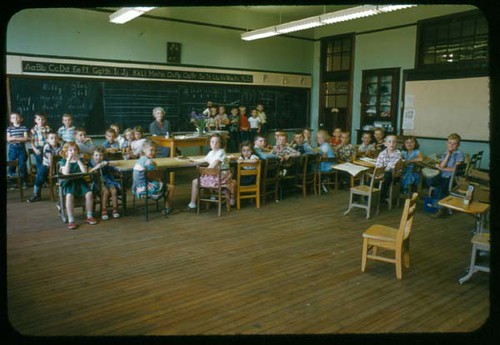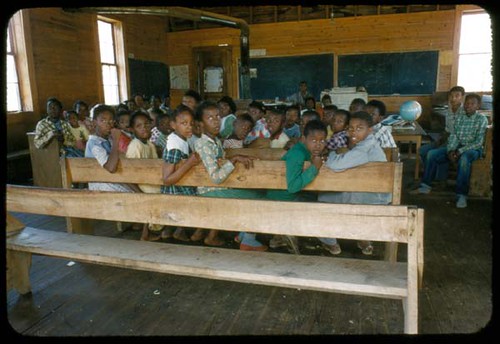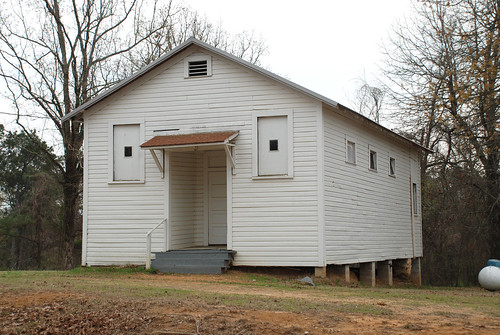“Separate free schools shall be established for the education of children of African descent; and it shall be unlawful for any colored child to attend any white school, or any white child to attend a colored school,”--Mississippi.

Panola County - Batesville School District - 1st Grade Classroom - 1955. University of Mississippi Visual Collections, John Elon Phay Collection
From the Mississippi History, "Rosenwald Schools in Mississippi," written by Jennifer Baughn: Public schooling in Mississippi did not become commonplace until after the American Civil War. After the United States Supreme Court decided in its 1896 Plessy v. Ferguson ruling that states could require separate public facilities for blacks and whites as long as they were equal (the so-called “separate but equal” doctrine), white-dominated school boards began concentrating more of their efforts and funding on schools for white children, rather than for black. By the early 1900s, while many white children studied their textbooks in new functional buildings, black students were often left to make do in churches, lodges, and poorly constructed buildings that barely kept out the wind and the rain.

Panola County - Eureka Springs School - All Grades- 1955, University of Mississippi Visual Collections, John Elon Phay Collection
Beginning in the 1910s, however, new school buildings for African Americans began to spring up on the Mississippi landscape. The schools, constructed as a partnership between the Julius Rosenwald Fund and local citizens, represented a leap forward for black southerners who wanted to ensure an education for their children. When the philanthropic program ended in 1932, a victim of the Great Depression, more than 5,000 school buildings had been constructed under its auspices in fourteen southern states. Mississippi’s Rosenwald program constructed six hundred and thirty-three schools and ancillary buildings and was the South’s second-largest state program.

The Rosenwald Fund — the product of an alliance between Booker T. Washington, president and founder of Tuskegee Institute in Alabama, and Julius Rosenwald, president and chief executive officer of Sears, Roebuck & Co. in Chicago — was the only philanthropic effort in the early 20th century to concentrate on improving the learning environment of black students in the South. The fund accomplished this by giving grants to black communities to cover about a third of the cost of a building. The communities were expected to match the Rosenwald money with either cash or in-kind contributions of labor and materials and to gain financial support from the public school system. While the communities gained a quality building, they also lost a measure of control over their children’s education when the school, which had usually been run by its own board of trustees, came under the control of the county superintendent of education.

Bynum School in Panola County, Mississippi
Begun at Tuskegee in 1912 and initially focused on the few counties surrounding that campus, the Rosenwald Fund’s fame grew through the extensive personal networks of southern blacks. By the end of the 1910s, several states surrounding Alabama had a few Rosenwald schools. But after Washington’s death in 1915, Rosenwald lost confidence in the fund’s new leaders at Tuskegee Institute. He moved the fund’s management away from Tuskegee and set up a new office run by foundation professionals in Nashville. During the 1920s, the Rosenwald Fund became increasingly standardized and efficient, approving thousands of grants in all of the southern states.

Julius Rosenwald founder of the Roesnwald schools.
In Mississippi, only a dozen or so schools obtained help in the early years under Tuskegee’s management. The early buildings were not built to standard plans and often were not much better planned than non-Rosenwald schools. A major shift occurred after the Rosenwald Fund’s reorganization in 1919-1920. By 1922, the Rosenwald Fund reported that one hundred and forty-one Rosenwald schools had been built in Mississippi, including fifty-eight three-teacher schools and five houses for teachers.
Built in 1926, the Bynum School in Panola County is the only surviving one-classroom Rosenwald school in Mississippi. Photograph by Jennifer Baughn. Courtesy Mississippi Department of Archives and History.
A NEW SCHOOL BUILDING: A primary focus of the newly reorganized Rosenwald Fund was the quality of the construction of school buildings that would be built with its funds. The fund wanted to build the most schools it could, but it also wanted them to meet current building standards and to be solidly constructed of good materials. Rosenwald also wanted to incorporate knowledge gained during a decade of careful study into lighting levels and ventilation. At the time, rural schools, and even some town schools, did not have electricity to provide lighting or heat. Thus, lighting needed to come into the building through windows, and studies had shown that schools needed many more windows than had previously been thought in order to give students sufficient light. In addition, new research showed that good ventilation prevented the spread of germs and diseases.

Using the findings from a survey of the existing Rosenwald schools by consultant Fletcher B. Dresslar, a recognized authority on the topic of school hygiene and good school planning, the fund, led by its new director Samuel L. Smith, drew a new set of standard plans that would be used to construct almost all Rosenwald schools in the 1920s. From 1920 onward, the Rosenwald Fund’s emphasis moved from funding “better schools” to encouraging “model schools” that could be standards for both black and white schools in the South.

Rosenwald plan for a one-teacher school. Courtesy Julius Rosenwald Fund, Community School Plans, Bulletin No. 3, Nashville, Tennessee, 1924.
The new plans allowed for a broad variety of schools, based on the number of teachers per school. Ranging from one-classroom structures with a gable front — a common school form in all areas of the country — to large twelve-classroom buildings with auditoriums, the plans relied on simple forms and construction techniques that would be accessible to the many volunteer laborers who built these schools. Several new features of the schools did in fact become models for school architecture in the 1920s, such as:

Prentiss Institute Rosenwald School, Prentiss, Jefferson Davis County
• One-story construction, which required slightly more land but was easier to build and was considered a safety improvement following several deadly school fires in two-story buildings.
• Large groupings of windows, concentrated on the east and west elevations of buildings, became the hallmark of schools for both black and white students in the 1920s. Previously, rural school buildings would have a few scattered windows, with windows on several walls of each classroom. Studies showed, however, that light from many directions caused a glare that could damage a student’s eyesight.

• Two school forms, the H-plan and the T-plan, became standard for rural and town schools alike in the 1920s. The Rosenwald standardized plans used these two forms almost exclusively for schools of four classrooms or more. Both plans contained an auditorium for school and community gatherings, but the H-plan was designed to face north or south, with its windows on the sides facing east and west, while the T-plan was designed to face east or west with its windows on the front and back. These simple but effective plans show the ingenuity and flexibility of the Rosenwald Fund’s program and the emphasis on quality even in difficult circumstances.

Prentiss Institute Rosenwald School, Prentiss, Jefferson Davis County
Only fifteen of the original five hundred and fifty-seven schools aided by the Rosenwald Fund are known to still stand in Mississippi. Of these, about half are either greatly altered or in a deteriorated state. The sole surviving one-classroom school is the Bynum School, built in 1926, in Panola County. Two good examples of the H-plan form are the concrete-block building (1926) at the Prentiss Institute in Jefferson Davis County, a six-classroom building constructed according to Rosenwald Plan #6-A, and the Brushy Creek School (circa 1930) in Copiah County, a clapboard Rosenwald Plan #4-A. The Drew Rosenwald school in Sunflower County began as a substantial T-plan Rosenwald, and grew over the years into a sprawling building with a large student population. The T-plan especially was popular because it could easily handle any needed expansion.
Brushy Creek School, 1930, in Copiah County, Mississippi
In addition to the known Rosenwald schools, Mississippi has some “ghost schools,” a group of schools that were supposed to have received Rosenwald Funds but the money was fraudulently diverted for personal use between 1923-1928. The Rosenwald agent at the Mississippi Department of Education, Bura Hilbun, who was responsible for overseeing the Rosenwald Fund in Mississippi and sending in final reports to the Nashville office, was later found to have falsified records and pocketed the money meant for certain schools. Hilbun’s fraud was found after he left the education department. He was convicted of embezzlement in 1931 in the Hinds County Circuit Court, after two hung juries. Hilbun appealed to the Mississippi Supreme Court but it upheld the lower court’s decision.

Poplar Hill School, Fayette vicinity, Jefferson County – (c. 1923) (National Register). Poplar Hill School in Jefferson County is a rare example of a rural school built in the early 20th century to serve the surrounding African American community. The one-story wood frame building with a side-gable metal roof was built c. 1923 and housed two classrooms. Two teachers were responsible for educating students from grades 1 through 8.
As a result of Hilbun’s falsified records, the historical records of the Rosenwald Fund at Fisk University Archives in Nashville list some schools that were not actually built, thus the “ghost schools.” One of those ghost schools has survived. Poplar Hill School is a rare two-classroom black school in rural Jefferson County, and while the school appears in the Rosenwald Fund database on the Fisk website, it is not, in fact, a Rosenwald plan and did not receive any Rosenwald funding. This was distressing news to a group of interested alumni who in 2009 pursued a National Register of Historic Places listing for the building as a Rosenwald school. Nonetheless, the building is still significant as a rare surviving rural African-American school, once one of thousands that dotted the Mississippi landscape.
Sherman Line School in Amite County, Mississippi, built in 1928. Photograph by Jennifer Baughn. Courtesy Mississippi Department of Archives and History.
BUILDING SCHOOL COMMUNITIES: The Rosenwald Fund did not stop with just building new classroom buildings for students. Located in rural areas with poor road systems, the schools came to be somewhat self-sufficient campuses, eventually including not only houses for teachers but also separate buildings for vocational and home economics education.
John White School teacher’s house (1925) in Forrest County
The Rosenwald Fund understood well the challenges of rural schools, and the first and most important one was attracting qualified teachers. School trustees often found it necessary to build a teacher’s house on the campus as a way to entice a principal who could oversee the school’s functioning. Not only did a teacher’s house keep principals and teachers longer at the school, but it provided security for the campus and an on-site alarm in case of fire. As it did with school plans, the fund offered several different house plans for teachers to accommodate families of various sizes. The Rosenwald Fund helped build fifty-eight teacher houses in the state, and many school boards built houses for teachers as well. At least two of the Rosenwald houses still stand in the state, the John White School teacher’s house (1925) in Forrest County and the former president’s house (circa 1930) at Coahoma Community College north of Clarksdale, a campus that began as one of only two agricultural high schools for African Americans. The other school was Hinds County Agricultural High School in Utica (1946).



Pope Chapel Elementary School, Panola County, 1955.
Vocational buildings or shops were also seen as a way to improve both the campus and the school’s educational program. The Rosenwald Fund emphasized vocational education not only because of its origins at Washington’s Tuskegee Institute but because training in agricultural and mechanical skills was thought to be the best way to educate rural children of both races for much of the first half of the 20th century. Indeed, backed by sufficient funding, white consolidated schools of the same period far outstripped black schools in providing buildings and teachers for vocational and home economics education and were considered better schools because of it. Only eighteen vocational buildings for black schools were constructed in Mississippi under the Rosenwald program, primarily because of lack of matching funds and because building a vocational building also meant hiring an extra teacher to teach the classes. This was often out of reach for the Rosenwald schools struggling to survive on limited funding from the public school boards.
Rose Hill School in Sharkey County, Mississippi, is a Rosenwald school.
By 1932, two years after Rosenwald’s death and three years after the stock market crash slashed the value of its endowment, the Rosenwald Fund ceased its building program, leaving southern blacks and southern progressives to find another solution for black education. (source: Mississippi History)

Extremely informative.
ReplyDeleteIt's truly a great and helpful piece of information. I am glad that you just shared this helpful info with us. Please stay us informed like this. Thank you for sharing.
ReplyDeletelehenga blouse designs by manish malhotra
quotes about romantic love
happy wednesday
Samsung
ReplyDeleteProfessor James D. Anderson's book on black education and Rosenwald takes an in depth view of how the education provided in these schools channeled students into low-paid jobs.
ReplyDeletenmgi
ReplyDeleteheyy bitches
ReplyDelete4k Video Downloader Crack
ReplyDeletewing-ide-pro-cracwebsiteAmazing blog! I really like the way you explained such information about this post with us. And blog is really helpful for us.
ReplyDeleteThanks for this post, I really found this very helpful. And blog about best time to post on cuber law is very useful. avast cleanup premium crack
ReplyDeleteThat is very interesting, You’re an overly skilled blogger. I’ve joined your rss feed and look ahead to in the hunt for more of your magnificent post. Additionally, I’ve shared your website in my social networks.https://raheelpc.com/media playercrack
ReplyDeleteThanks for provide great informatic and looking beautiful blog, really nice required information & the things i never imagined and i would request, wright more blog and blog post like that for us. Thanks you once agian scriptcase-crack
ReplyDeleteThis is the software-based company where you can find and demand different software such as Avast Secureline VPN Crack Kindly click on here and visit our website and read more.
ReplyDeleteUc Browser Mod APK
Avast Secureline VPN Crack
Avast Driver Updater Key Crack
Avast Cleanup Premium Crack
Luxion KeyShot Crack
Amazing blog! I really like the way you explained such information about this post with us. And blog is really helpful for us.uvk-ultra-virus-killer-crack/
ReplyDeleteSuch a nice and helpful piece of information. I’m so happy that you shared this helpful information with us. Please keep us up to date like this. Thanks for sharing.auslogics-boostspeed-crack/
ReplyDeleteWondershare Dr Fone Crack
ReplyDeleteAvast Driver Updater Crack
Cracks
Teamviewer Crack
Total Av Antivirus Crack
Gridinsoft Anti Malware Crack
This is most advance school like international school in jaipur in their era but now this one is leading.
ReplyDeleteGroup study and brainstorming is always effective and camouflages better study environment. Study from the Right Books. Do's in the Final Year MBBS in Army Medical College Admission
ReplyDeleteDownload Free Premium Software
ReplyDeleteOutput Messenger Crack
netbalancer crack
smadav pro crack
I am very happy to read this article. Thanks for giving us Amazing info. Fantastic post.
ReplyDeleteThanks For Sharing such an informative article, Im taking your feed also, Thanks.
actual-window-minimizer-crack/
ReplyDeleteHello Everyone this page has usefull information,as i found the content in the post this also have the relative ideas, Thanks...!!
KMPlayer Crack
Hitman Pro Crack
EaseUS partition master crack
Final Cut Pro X Crack
Winstep Nexus Ultimate Crack
ReplyDeleteI am very thankful for the effort put on by you, to help us, Thank you so much for the post it is very helpful, keep posting such type of Article.
CyberLink PowerDirector Ultimate Crack
Winthruster Crack
iTop Screen Recorder Pro Crack will be a complicated screen-recording developer that permits consumer to imprison somewhat top recording of present display process. Consumer can detain icons, facial webcam, as well as microphone through not any arithmetical through several trustworthy series.
ReplyDeleteiTop Screen Recorder Pro Crack